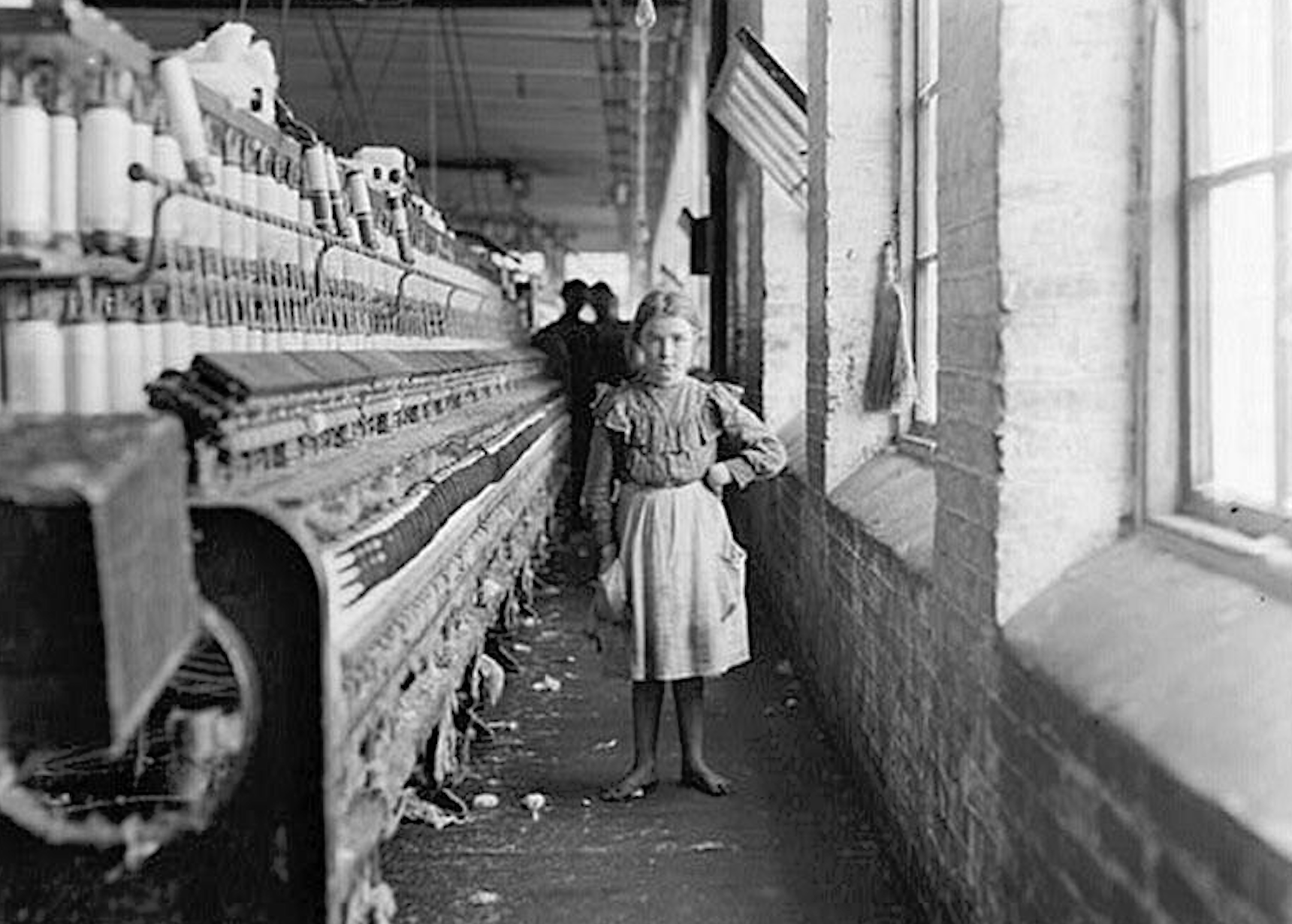
The Fabric of Civilization
America’s first exports were spun in southern textile mills. Contributor BRENDA WENSIL remembers the golden era of cotton.

via David Vance
It was the perfect hiding place: that little gap between the bedroom sets and rows of couches, dining room tables, bedroom suits and reclining chairs. My Dad would never find me here. So I sat, curled up and quiet, listening to the sounds of his furniture store. For a seven year old, this was the ideal space to listen to my Mother’s adding machine clicking away in the office, and watch my Father extolling the values of handcrafted furniture and upholstery to his loyal customers.
Eight-way. Hand Tied. Notch-in-Groove. Hand Crafted. These were the catch phrases of my youth heard thousands of times with a particular point of pride. “Let me show you the fabric choices,” my Dad would say, fanning literally hundreds of swatches from which to choose. He would slide his hand across the cloth and ask the customer to do the same as he talked about beauty, durability and richness of colors. As I hid and listened, I would press my small face against the fabric of a couch as I drifted off into my dreams. Sometimes he would wake or pull me out of hiding to say hello to customers. Nearly everyone knew and trusted my Dad and that’s how things work in a small South Carolina town. Few knew more about furniture than he, though his real talent was extol¬ling the virtues of textiles. But that was then.
As a child hiding among the rows of furniture, I could not have known that my small face was pressed against a legacy of labor, progress and innovation. I could not have known that the hand carved and crafted wood furniture made just up the road was a by-product of the textile industry itself and was fueling retail stores like my Dad’s all over the country. In fact, it was all that and more. For the sum total of those thousands of threads against my face was, in fact, symbolic of imperialism and the historic rise, fall and redemption of the American South.
A Danish tale tells of weavers that one day promised an Emperor a new suit of clothes. The suit, they said, would be invisible to those unfit for their positions. The newly clothed Emperor, pretending that he can see the fabric, parades before his subjects who are equally afraid of admitting they actually see nothing at all. After a child cries out the obvious reality that the Emperor has no clothes on, the masses reluctantly begin to admit the same.
The Emperor’s New Clothes has become a standard metaphor for collective denial, or any group dynamic that prevents a healthy challenge to authority when speaking the truth. Similarly, the textile industry of the past 30 years was equally unwilling to admit an escalating problem that no one wanted to address or discuss: that of its gradual competitive demise to foreign countries. Political leaders saw the markets rebounding, and therein lies our tale.
Beauty and creature comforts are the threads, and most enduring themes of civilization. History records garments from 550 B.C. embroidered with “wool from a tree” or cotton. Wool was woven into garments thousands of years ago in ancient Egypt and trimmings were fashioned to adorn the lush tapestries in Persian Palaces. From the days of Pharaoh, cotton has clothed and comforted every civilization and society. Fiber from the flax plant was woven into linen that provided clothing, shrouds and sails for Pharaoh’s realm. And eventually cotton, which made all this possible, would become the dominant material of the world’s textile industry.
From the most basic necessities of our time right up to the most exquisite artifacts of beauty, the textile industry has been the great provider. The industry of fiber to fabric and design to dyes, textiles brought woven beauty into the homes of the world and became part of virtually everything we touch in nearly every moment. The economic crown jewel, American Textiles, ruled that landscape at home and abroad. It fueled emerging economies, created jobs, and provided a living for scores of people seeking a better life. But eventually a changing world pulled at the edges: fraying the fabric as emerging nations offered a less expensive route. Cheap labor abroad and consumer demand for the lowest possible prices set the industry on a collision course that has seen the great textile empire rise, fall and struggle to redeem itself.
Textiles in America
Before taking a journey through its gloried past, consider the here and now. Virtually everything one might see or touch or need in the simple span of five minutes has a pretty good chance of being a product of the textile industry or a by-product of its fortune. If it is wearable, it is from textiles. If it shades your room or creates charm and depth in your home, it is a textile product. But it doesn’t stop there. Wherever you live, particularly in the Piedmont region of North Carolina, there is probably not an industry or business in existence that does not have textiles to thank.
Perhaps best known as one of the largest financial centers in the nation, Charlotte’s very financial roots can be traced to the mill owners and small banks established at the turn of the century to give financial support to the growing textile industry. In fact, the growth of banks and mills were inextricably linked throughout the 20th Century. By the late 1980s, First Union (later Wachovia and Wells Fargo) and North Carolina National Bank (later Bank of America) would usher in interstate banking, allowing for growth and consolidations in the financial industry unprecedented in history. For example, in the early 1900s, the South’s gooey summers were not the only kind of heat to be endured. The heat generated by textile machinery in mills combined with the often-oppressive climate made working conditions unimaginable to this generation, and overheated machinery, in particular, created fire hazards that could halt production. To address the issue, Cramerton, who was one of the legendary mill owners of the time, developed a cooling device to keep his machines in motion. Working with a partner, Carrier, the two created designs for the devices and installed them in the factories. The patents for the cooling systems remain in the Cramerton name to this day and this invention, referred to as “Air Conditioning,” ultimately transformed not only the US South but the entire nation and ultimately the world. In the end, textiles ushered in a wave of commerce and prosperity that has made the region what it is today: economically diverse and capable of sustaining itself through even the most challenging of markets.
Textiles are perhaps the birthright of nearly every emerging economy and developing nation. Today, the nations of China, India, Pakistan, Taiwan and others have emerged to take their turn in this business. But centuries ago, it belonged to England, France and ultimately, to a developing country called America.
The world longed for cotton, and nearly every developing nation answered the call. Centuries ago, England’s powerful new cotton industry was centered in Lancashire where the damp climate was sympathetic to cotton fibers, water power was available and fuel was cheap. The discovery of the power of steam together with the automation and mechanization of spinning cotton created the Industrial Revolution in Britain. From Britain the Industrial Revolution took hold in Europe and then across the seas. Textiles expanded into the US when our Founders removed British colonial restrictions at the time of independence in 1776. Industrialism from then on was the mantra and muscle of the new working middle class.
It first took root in the American Northeast, particularly the New England states of Rhode Island and Massachusetts, because of their geographic location and progressive political climate. Before long, the opportunity moved to the South struggling to reclaim itself from Reconstruction. Cotton had been “king” in the south since Colonial days, but most of the raw fiber had been shipped to the cotton mills of New England and Europe where the Industrial Revolution was in full force. A product of the West Indies, cotton adapted well to the climate of the southern states, though was difficult to process until an American, Eli Whitney, invented his Cotton Gin in 1793 which separated seeds from fiber and pushed the fledgling industry forward into an extensive cotton textile industry in full bloom.
From then on, the South’s economy was almost totally tied to one-crop agriculture and the importation of slaves to cultivate the staple gave it distinctiveness like no other. The problem, of course, with one-crop agriculture is that it breeds dependence and subjugation which imposed upon the country unintended social and political consequences for generations to come.
Southern Gold
As in every remarkable story, triumph is preceded by a great struggle. For America’s South, groping for a foothold to rise from the economic and political destruction of the Civil War and the social tragedy of Reconstruction, cotton production became the savior. This ancient and storied industry took its turn at becoming the salvation of the south. From countries throughout the world, the opportunity of textiles made its way from America’s Northeast to the South and directly to the heart of the Piedmont region of North Carolina to become the most prominent in the world: an industrial powerhouse of a progressive New South Economy.
The Carolina Piedmont had the perfect alignment of everything that made textiles possible. Situated at the base of the majestic Blue Ridge Mountains and at the mouth of the powerful Catawba River, it was along the lines of some of the first railroads of the territory and close to a labor force that was slowly losing strength in the sparsely populated agricultural region. Industry came to the river valleys where inexpensive power was readily available and then to the inland areas as steam and eventually electric power proved more reliable.
As in any mass migration, a variety of individual and personal circumstances led to the decision to abandon the farm and take up work in the mill. The sons and daughters of small farmers recognized that the future in farming was not bright and responded quickly to the invitations of labor recruiters. More than in any previous generation, the ranks of labor were filled by entire farm families beaten down by a seemingly endless cycle of crop failure, pest invasions, low prices and indebtedness. The long-suffering rural people sought nothing more than the basic security of cash wages, a company house, and perhaps an education for their smaller children. But for so many migrants, the smokestacks of cotton mills did not represent freedom. In fact, going to work in mills was the final misfortune as they surrendered the basic ideals of self-sufficiency, independence and the traditional values that had sustained them for generations.
But no other industry gave jobs and stability to so great a number of needy people as did the southern cotton textile industry in the years after Reconstruction. The New South was comprised of North and South Carolina, Virginia, Georgia, Tennessee and Alabama. And the cotton industry was solely responsible for these states’ financial independence, progress and growth. Known as Southern Gold, it represented the prosperity and progressive nature of the South as it not only harvested the cotton, but learned to manufacture, market and ultimately to innovate the fibers for nearly 100 years.
By 1941, the cotton business employed more than 10 million people. Following World War II, King Cotton was at the pinnacle of prominence and textiles governed a significant share of the southern economy. The industry employed hundreds of thousands in the Carolinas and millions throughout the nation. It was a Golden Era that has seen few parallels in its long history. But in time, one by one, the fall of greatness would make the industry’s landscape a thin reflection of its once great and powerful self.
From fiber to fabric and design to demand, perhaps no one knows the highs and lows of the design end of the industry like Wesley Mancini. He is among the last of the great designers still working his craft in an industry that has fragmented itself across the world. But the name Mancini connotes more than three decades of excellence in the pursuit of the highest perfection. Today his work is sought after for its elegance all over the world.
In the glory days of textiles, not more than three decades ago, the large mill houses of Concord and High Point were teaming with designers, new fabrics, colors and possibilities. It was the ‘70s, and Mancini was early in his career. Born to dairy farmers in Connecticut, Mancini entered Philadelphia College of Textiles and Science (now the University of Philadelphia) where he tried his hand as a fiber artist before determining to become a designer. Looking for jobs after school became challenging as his portfolio had high-end appeal and his work with silks and wools made prospective employers leery that he couldn’t relate to the average buyer.
Mancini followed the industry’s movement to the South when early in his career he took a job with Home Fabrics. Here he literally overhauls a highly commercial line into a more decorative appeal and is ultimately asked to manage a line of bedding. In short time he transformed the line of bedding, trim and upholstery taking the company’s home fashion business from 7M to 70M annually while driving the most important component of the entire textile process: consumer demand. Soon he had created a niche for himself in an industry that had been a dominant force and looked to stay that way. He created his own company and from there continued the association with Home Fabrics for another 23 years.
Walking through his studio, his role and power are clear. He says the upcoming season will be fond of grays – and so it is. The walls of his offices are covered with color and texture groupings to display the many combinations of the new looks to come. This is where style is defined and translated before the world ever sees it, before a buyer ever wants it, before a merchandiser ever sells it, and long before you’ll ever know how much you love it. Mancini is not merely a designer. He is the “decider” of consumer demand. He is constantly collecting fabrics from Europe that are centuries old and re-interpreting them into the look of the future. From the fields to the mills to the designers to your home, Mancini has been creating classics and redefining style through innovative textures and colors for more than 30 years. As creator of home décor accessories, his are the most sought after bedding and furniture brands.
Through the years his design firm experienced constant growth working with the furniture greats such as Clyde Pearson, Hickory Chair, Henredon. There seemed to be no end to the flow of design ideas, opportunities in every market, particularly the market niches that yearned for extravagance and elegance. But then, he recalls, two events helped turn the tide. One was September 11, 2001, and the other was the lifting of trade embargoes. At home, it did not take long to feel the impacts of the reduced consumer spending created by 9-11, and the loss of jobs to offshore opportunities as a result of lifted trade sanctions. The long-standing U.S. policies toward China (and other emerging markets) began to loosen and by the late 1990s, trade sanctions with that nation began to lift allowing for more import/export opportunities.
China was providing product and labor at nearly a quarter of the domestic price and as large brands began to falter the auxiliary divisions, such as bedding and draperies, went with them. The domino effect impacted yarn manufacturers, dyers, finishers, and everyone along the chain. With access to the cheaper labor forces of these developing nations, the large conglomerates turned their eyes offshore. And history began to repeat itself as emerging countries grasped for the opportunity of textiles. Mancini began work with a mill in China, and would be among the first to explain the challenges of such an arrangement. Multiple sources, he says, are needed for anything done in China as there is no yarn inventory and no consistency in color dyes, making it next to impossible to provide a top quality product. The process required one compromise after another in the details that Mancini has spent a lifetime perfecting.
Still, Mancini believed the market would come back. But the tides were changing on a permanent scale and before long the losses mounted. His strength slipped as he held onto staff and resources through the worst of the storm. As mills tried to lower margins and make things cheaper, the situation spiraled and nothing seemed to work. He reflects on a time when America produced its own products – Made in the USA - and the world bought. But in a global economy the name of the game is cost, not quality, and the pressure to cut cost and kowtow to consumer demands created a momentum toward consolidation, offshore jobs and products. The ultimate culprit in our spiral toward mediocrity is, of course, the consumer.
Today his business is international with England as the number one market, followed by Germany, Italy and a growing market in the Middle East. He has expanded his lines to include hardware such as curtain rods that augment the full line home accessories. Mancini’s influence on the shape of the industry’s future will be felt. He is a member of the Board of Directors for the International Textile Market Association (ITMA), the first designer ever to be named to its board; Savannah College of Art and Design; University of Philadelphia; NC State University; The Mint Museum of Craft & Design; The McColl Center for Visual Art; and the Wesley Mancini Foundation.
Factors of the Fall
Restructuring the industry created significant change. Automation, specialty marketing, and promotional campaigns all contributed to sustaining the competitive advantage of American textile manufacturers against the invasion of imported textile products. However, the textile industry underwent a radical restructuring that reversed century-long trends in ownership, employment, and production. The crisis in import competition created a wave of plant closings and layoffs throughout North Carolina and other textile-producing states. Consolidations brought more changes. But the most dramatic change in the 1980s was a series of spectacular mergers and takeovers that involved the pillars of the state’s textile industry. With investor confidence sagging as a result of the losing battle against imported goods, textile stocks were selling at sharp discounts. Several companies returned to private ownership through leveraged buyouts while others succumbed to the merger and takeover mania.
At the same time, other textile companies were undergoing a period of stagnation and decline. The collective pressures of government policy and regulations, labor activism, foreign competition, social criticism and technological change created challenges that strained the capacity of manufacturing operations and their ability to sustain themselves. More than 200 mills have closed since 2005, when the nations of the World Trade Organization agreed to drop the quotas that once regulated the global trade in fabric and clothing. About 410,000 American workers still work in Textile and Apparel manufacturing as compared to the 1.6 million who worked in the industry in 1990. You do the math.
As Mancini experienced, many factors contributed to the gradual decline of textiles in the United States. Chalk it up to a changing world and the emergence of developing countries hungry for jobs. Blame the industry’s own directive for efficiency or point to consumer demand for cheaper products. Whatever combination of factors you subscribe to the end result is clear: the landscape of the US Textiles Industry began to change forever.
In the long expanse of time and history, 100 years is barely a blip on the radar. But the century of textile greatness left in its wake a momentum of progress that is still felt today. Although its economic prominence is not what it was, and textiles play a far smaller role in the life of the U.S. and the region, its existence continues to have a powerful influence in the social, economic, religious, financial and educational make up. In pure economic terms, there are fewer mills and far fewer manufacturing employees, but their unit output is far greater due to state of the art machinery that gives more production per spindle or loom in less time with fewer workers. This inevitable economic trend resulted in large part because of advanced technology that made mills more productive and nicer places to work, but required fewer workers to operate the machinery.
The Emperor’s New Clothes, we might say, are now dependent not on a weaver’s tale but on ingenuity, innovation and technology. Today the American textile industry is the world’s most efficient manufacturer of textiles and continually working on new ideas and products to maintain its position as a world-class producer. Against the ever-present threat of cheap foreign labor, research and education have been key factors to the advances in new yarns, fabrics and other products that appeal to consumers. Pharr Yarns, for example, is one of several plants spinning flame resistant fibers, which is ultimately shipping to war zones and reducing second and third degree burns by as much as 44%. Other companies are making constant investments in automation that will allow for high speed, highly specialized and engineered fabrics that cannot be easily copied at a lower cost. Consolidation and control by larger, more diversified firms with greater access to large amounts of capital for modernization and improvements continue to transform the business. These firms are able to institute economies, make long-range capital investments in plants and equipment, and forge new technologies that will keep the industry competitive and cost efficient.
Invisible Labor
Since those days of hiding behind couches, I’ve segued into one of those soaring skyscrapers within Charlotte’s financial services industry that is today the second largest banking center in the United States. And in all those years as a professional I can’t recall even one gooey summer day without the benefit of air conditioning. Who would have ever guessed that this little “convenience” would have come of a production challenge in a southern cotton mill? As a professional woman, I wear every possible variation of clothing from athletic wear that whisks away water and keeps me dry, to business attire and evening wear that can be packed and unpacked without a wrinkle. I see our servicemen on the news and somehow feel they are safer, clothed in the most advanced fire-repellant fibers and even furnish my home with furnishing still made right up the street. How could any of us have known how the US South would influence the world? For these are the threads that connect and define us all.
It has been several decades now since those naps in my Dad’s furniture store, and resting peacefully against the fabric of an industry I took for granted. It’s very existence in our history guarantees vibrant markets, job opportunities in a myriad of industries, and the promise of prosperity. Creativity, innovation and perseverance are the essence of the American Spirit and no other industry is as old or noble as textiles. Beyond its power as an industry, it is an ageless quest for comfort, art and decorative beauty demonstrated through the world’s garments, tapestries and fabrics. The rise to greatness and the inevitable struggle and downfall that followed nearly a century later is of consequence only in light of the world it helped create. Without America’s contribution to this timeless industry, without the South’s historic hand in that long line of progress, without the new world stage upon which it now plays there would be a void of invention and beauty throughout civilization. The Emperor’s New Clothes, in the end, were not sewn from yarn and threads and fabric we can see, but by innovation, enterprise and the imagination of the human spirit.
Archives








